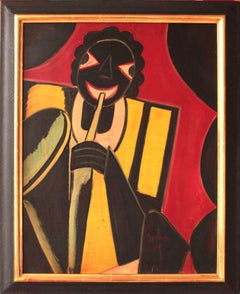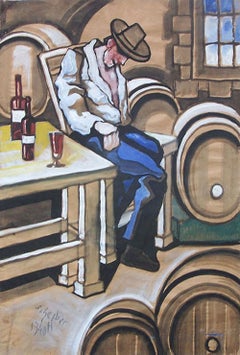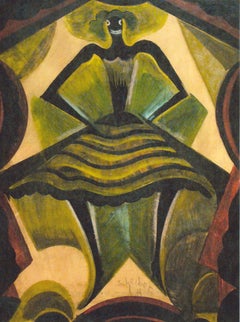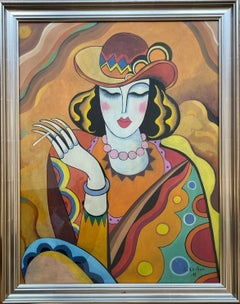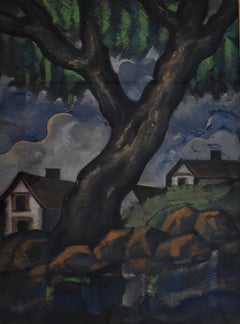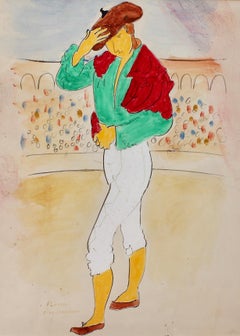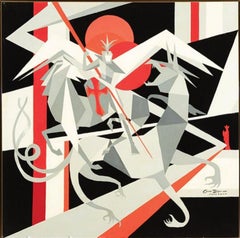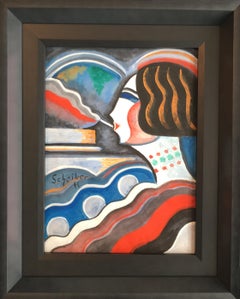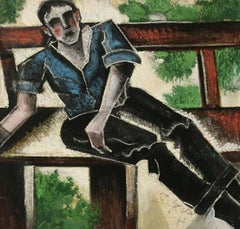Hugó Scheiber Art
to
4
1
5
1
1
Overall Width
to
Overall Height
to
12
5
2
2
3
2
2
11
1
8
5
4
3
1
1
1
1
1
1
1
1
1
8
7
7
5
5
13
7,763
4,946
2,504
1,372
3
10
2
Artist: Hugó Scheiber
Rare Modernist Hungarian Rabbi Pastel Drawing Gouache Painting Judaica Art Deco
By Hugó Scheiber
Located in Surfside, FL
Rabbi in the synagogue at prayer wearing tallit and tefillin.
Hugó Scheiber (born 29 September 1873 in Budapest – died there 7 March 1950) was a Hungarian modernist painter.
Hugo Scheiber was brought from Budapest to Vienna at the age of eight where his father worked as a sign painter for the Prater Theater. At fifteen, he returned with his family to Budapest and began working during the day to help support them and attending painting classes at the School of Design in the evening, where Henrik Papp was one of his teachers. He completed his studies in 1900. His work was at first in a post-Impressionistic style but from 1910 onward showed his increasing interest in German Expressionism and Futurism. This made it of little interest to the conservative Hungarian art establishment.
However, in 1915 he met the great Italian avant-gardist Filippo Tommaso Marinetti and the two painters became close friends. Marinetti invited him to join the Futurist Movement. The uniquely modernist style that he developed was, however, closer to German Expressionism than to Futurism and eventually drifted toward an international art deco manner similar to Erté's. In 1919, he and his friend Béla Kádar held an exhibition at the Hevesy Salon in Vienna. It was a great success and at last caused the Budapest Art Museum to acquire some of Scheiber's drawings. Encouraged, Scheiber came back to live in Vienna in 1920.
A turning point in Scheiber's career came a year later, when Herwarth Walden, founder of Germany's leading avant-garde periodical, Der Sturm, and of the Sturm Gallery in Berlin, became interested in Scheiber's work. Scheiber moved to Berlin in 1922, and his paintings soon appeared regularly in Walden's magazine and elsewhere. Exhibitions of his work followed in London, Rome, La Paz, and New York.
Scheiber's move to Germany coincided with a significant exodus of Hungarian artists to Berlin, including Laszlo Moholy-Nagy and Sandor Bortnyik. There had been a major split in ideology among the Hungarian avant-garde. The Constructivist and leader of the Hungarian avantgarde, Lajos Kassák (painted by Hugó Scheiber in 1930) believed that art should relate to all the needs of contemporary humankind. Thus he refused to compromise the purity of his style to reflect the demands of either the ruling class or socialists and communists. The other camp believed that an artist should be a figurehead for social and political change.
The fall out and factions that resulted from this politicisation resulted in most of the Hungarian avant gardists leaving Vienna for Berlin. Hungarian émigrés made up one of the largest minority groups in the German capital and the influx of their painters had a significant effect on Hungarian and international art. Another turning point of Scheiber's career came in 1926, with the New York exhibition of the Société Anonyme, organized by Katherine Dreier. Scheiber and other important avant garde artists from more than twenty-three countries were represented. In 1933, Scheiber was invited by Marinetti to participate in the great meeting of the Futurists held in Rome in late April 1933, Mostra Nazionale d’Arte Futurista where he was received with great enthusiasm. Gradually, the Hungarian artists began to return home, particularly with the rise of Nazism in Germany. Kádar went back from Berlin in about 1932 and Scheiber followed in 1934.
He was then at the peak of his powers and had a special flair in depicting café and cabaret life in vivid colors, sturdily abstracted forms and spontaneous brush strokes. Scheiber depicted cosmopolitan modern life using stylized shapes and expressive colors. His preferred subjects were cabaret and street scenes, jazz musicians, flappers, and a series of self-portraits (usually with a cigar). his principal media being gouache and oil. He was a member of the prestigious New Society of Artists (KUT—Képzőművészek Új Társasága)and seems to have weathered Hungary's post–World War II transition to state-communism without difficulty. He continued to be well regarded, eventually even receiving the posthumous honor of having one of his images used for a Russian Soviet postage stamp (see image above). Hugó Scheiber died in Budapest in 1950.
Paintings by Hugó Scheiber form part of permanent museum collections in Budapest (Hungarian National Museum), Pecs (Jannus Pannonius Museum), Vienna, New York, Bern and elsewhere. His work has also been shown in many important exhibitions, including:
"The Nell Walden Collection," Kunsthaus Zürich (1945)
"Collection of the Société Anonyme," Yale University Art Gallery, New Haven, Connecticut (1950)
"Hugó Scheiber: A Commemorative Exhibition," Hungarian National Museum, Budapest (1964)
"Ungarische Avantgarde," Galleria del Levante, Munich (1971)
"Paris-Berlin 1900-1930," Centre Georges Pompidou, Paris (1978)
"L’Art en Hongrie, 1905-1920," Musée d’Art et l’Industrie, Saint-Etienne (1980)
"Ungarische Avantgarde in der Weimarer Republik," Marburg (1986)
"Modernizmus," Eresz & Maklary Gallery, Budapest (2006)
"Hugó Scheiber & Béla Kádár," Galerie le Minotaure, Paris and Tel Aviv (2007)
Hugó Scheiber's paintings continue to be regularly sold at Sotheby's, Christie's, Gillen's Arts (London), Papillon Gallery (Los Angeles) and other auction houses.
He was included in the exhibition The Art Of Modern Hungary 1931 and other exhibitions along with Vilmos Novak Aba, Count Julius Batthyany, Pal Bor, Bela Buky, Denes Csanky, Istvan Csok, Bela Czobel, Peter Di Gabor, Bela Ivanyi Grunwald, Baron Ferenc Hatvany, Lipot Herman, Odon Marffy, C. Pal Molnar...
Category
Early 20th Century Modern Hugó Scheiber Art
Materials
Paper, Charcoal, Pastel, Watercolor, Gouache
"Jazz Musician" Oil Painting 1930 by Hugó Scheiber
By Hugó Scheiber
Located in Berlin, DE
Oil on wood, 1930. Signed lower right. Framed. Height 31.10 in ( 79 cm ), Width 25.19 in ( 64 cm )
The Hungarian artist Hugó Scheiber lived 1922-1934 in Berlin, that's where he pain...
Category
1930s Cubist Hugó Scheiber Art
Materials
Oil, Wood Panel
At the Winery - Hungarian Art
By Hugó Scheiber
Located in London, GB
This original painting is hand signed by the artist "Scheiber H" in the lower left corner,
and dated "1940" below the signature.
Exhibited: Hugo Scheiber - Bela Kadar, Galerie Le Mi...
Category
1940s Hugó Scheiber Art
Materials
Tempera, Gouache
Hugó Scheiber Theater Scene with a Dancer, Gouache ca. 1920
By Hugó Scheiber
Located in Berlin, DE
Gouache on paper, 1920's by Hugò Scheiber ( 1873-1950 ) Hungary. Signed with pencil lower central: Scheiber H.
Framed under glass. Height: 25.98 in ( 66 cm ), Width: 19.69 in ( 50 c...
Category
1920s Expressionist Hugó Scheiber Art
Materials
Gouache, Paper
"Woman with a Cigarette", Hugo Scheiber (1873-1950)
By Hugó Scheiber
Located in Paris, FR
Hugo Scheiber (1873-1950) was a Hungarian painter of Jewish origins. He started as a self-taught artist. He was initially inspired by Impressionism before evolving towards Expression...
Category
1920s Expressionist Hugó Scheiber Art
Materials
Gouache, Cardboard
Landscape with Tree and Houses
By Hugó Scheiber
Located in London, GB
HUGO SCHEIBER 1873-1950
1873 - Budapest-1950 (Hungarian)
Title: Landscape with Tree and Houses, circa 1930's
Technique: Signed Gouache and Pastel Painting on Paper
Size: 67.5 x 48...
Category
1930s Art Deco Hugó Scheiber Art
Materials
Gouache, Pastel
Deco Dancing Hungarian Expressionism European Drawing Modernism Figurative Dance
By Hugó Scheiber
Located in New York, NY
Deco Dancing Hungarian Expressionism European Drawing Modernism Figurative Dance. 22 1/2 x 16 inches. Signed lower left. Framed.
BIO
Hugó Scheiber was born in Budapest in 1873. At the age of eight, he moved with his family from Budapest to Vienna.
In 1898, to help support his family after they had returned to Budapest. He started working during the day, attending painting classes at the Commercial Art School in the evening. In 1900, he completed his studies.
Scheiber showed an early interest in German Expressionism and Futurism. In 1915 he met Marinetti, who invited him to join the Futurist movement. Because Scheiber's paintings conflicted with academic style of the Hungarian art establishment, his work was virtually ignored in his own country. In 1919, he and his friend Béla Kádár held an exhibition organized by Hévesy in Vienna, which was a great success, so much so that the Budapest Art Museum purchased two of his drawings.
In 1920, Scheiber returned to Vienna. A turning point in his career came in 1921 when Herwarth Walden, founder of Germany's leading avant-garde periodical, Der Sturm...
Category
1920s Art Deco Hugó Scheiber Art
Materials
Paper, Gouache
Hugó Scheiber "Portrait of a Woman", 1925
By Hugó Scheiber
Located in Berlin, DE
Pencil, charcoal, ink on paper, 1925 by Hugó Scheiber ( 1873-1950 ), important artist of Hungarian modernity. Signed lower center: Scheiber H. Dimensions: 13.78 x 9.84 in ( 35 x 25 ...
Category
1920s Modern Hugó Scheiber Art
Materials
Mixed Media
Hugó Scheiber Pastel "Sailing", about 1930
By Hugó Scheiber
Located in Berlin, DE
Pastel and carbon pencil on cardboard, ca. 1930 by Hugo Scheiber. Signed lower left: Scheiber H.
Dimensions: 14.96 x 12.99 in ( 38 x 33 cm ), Framed: 19.69 x 15.75 in ( 50 x 40 cm )
...
Category
Early 20th Century Expressionist Hugó Scheiber Art
Materials
Pastel, Cardboard, Carbon Pencil
Self Portrait
By Hugó Scheiber
Located in London, GB
HUGO SCHEIBER 1873-1950
1873 - Budapest - 1950 (Hungarian)
Title: Self Portrait
Technique: Original Signed Pastel Drawing on Paper
Size: 37.7 x 30 cm. / 14.8 x 11.8 in.
Additiona...
Category
1940s Futurist Hugó Scheiber Art
Materials
Pastel
The Rhythm of the City - Hungarian Art Futurism Cubism
By Hugó Scheiber
Located in London, GB
HUGO SCHEIBER 1873-1950
1873 - Budapest - 1950 (Hungarian)
Title: The Rhythm of the City, 1920's/1930's
Technique: Original Signed Charcoal and Pastel Drawing on Paper
Size: 61 x ...
Category
1920s Cubist Hugó Scheiber Art
Materials
Charcoal, Pastel
The Rest
By Hugó Scheiber
Located in London, GB
HUGO SCHEIBER 1873-1950
1873 - Budapest - 1950 (Hungarian)
Title: The Rest
Technique: Signed Gouache Painting on Brown Paper
Size: 35.5 x 49 cm. / 14.8 x 1...
Category
20th Century Hugó Scheiber Art
Materials
Gouache
Related Items
La Montera
By Pierre Ambrogiani
Located in London, GB
'La Montera', gouache, watercolour and ink on art paper, by Pierre Ambrogiani (circa 1960s). The artist created many artworks with bullfighting as theme. In this case, a single torer...
Category
1960s Expressionist Hugó Scheiber Art
Materials
Paper, Watercolor, Gouache
"St. George and the Dragon" - Large Late 20th Century Framed Painting
Located in New Orleans, LA
You don't have to be a Catholic, or a medievalist, or a Catholic medievalist (Tolkien?) to appreciate this striking image of St. George taking on the dragon. In style it falls somewhere between Cubism and Guernica, to my eye. The limited color palette, with the bold red, gives it the energy of early 20th-century Russian poster...
Category
1980s Cubist Hugó Scheiber Art
Materials
Oil
Spirit
By William Y. Cooper
Located in Buffalo, NY
"Spirit" a bold and thoughtful cubist oil on canvas was painted in December of 2001 by African American artist William (Bill) Cooper.
William Y. Cooper was a writer, painter, muralist, illustrator, and art teacher. He moved to Western New York in 1954 from Birmingham, Alabama, to pursue work, and Buffalo has been his home ever since. In 1975, he received his Bachelor of Fine Arts degree from the University at Buffalo; he was also a state certified art teacher.
Cooper woked primarily in oils and acrylics, but also creates drawings on paper. He has painted several commissioned murals and has had more than fifteen one-man shows in Western New York and Ghana, West Africa, and has participated in more than twenty-five group exhibitions since he began his professional career in 1969.
His paintings and drawings address both his African heritage and his experience as an American through symbolism and metaphor. He observes, “I am an Afrocentric artist. My worldview is rooted in an African frame of reference and a deep, abiding sense of the creator from whence I draw my inspiration, strength, and a sense of who I am. The use of symbols allows me to explore literal ideas.”
Among Cooper’s published works are two children’s books, 77 Jackson Street, Rear and Nakai and the Red Shoes, and a novel for adults, The Mopane Tree.
Cooper founded the Afrocentric Artists’ Collective and ran the organization from 1979 to 1981. In 2013 he was designated a “Living Legacy” artist by the Burchfield Penney Arts Center, the latest in a series of honors which has also included awards from the Arts Council of Buffalo & Erie County, the New York State Council on the Arts, and Alpha Kappa Alpha...
Category
21st Century and Contemporary Cubist Hugó Scheiber Art
Materials
Canvas, Oil
Blue Rolling Waves off Sidney, Seascape Diptych Cyanotype, Australian Coast Surf
By Kind of Cyan
Located in Barcelona, ES
This is an exclusive handprinted limited edition cyanotype.
"Rolling Waves off Sidney" is a gorgeous original cyanotype diptych showing energetic waves embracing the Australian coas...
Category
2010s Photorealist Hugó Scheiber Art
Materials
Emulsion, Watercolor, Lithograph, Monotype, Rag Paper
Romantic Landscape of Scandinavian Enchanted Forest, Large Lake Print Cyanotype
By Kind of Cyan
Located in Barcelona, ES
This is an exclusive handprinted limited edition cyanotype.
Lovely scene of a hidden pond in a Scandinavian forest.
Details:
+ Title: Scandinavian Enchanted Forest
+ Year: 2024
+ ...
Category
2010s Romantic Hugó Scheiber Art
Materials
Photographic Film, Emulsion, Watercolor, Photographic Paper, C Print, Co...
Blue Pacific Foamy Shorelines, Horizontal Calm Seascape, Minimal Waterscape
By Kind of Cyan
Located in Barcelona, ES
This is an exclusive handprinted limited edition cyanotype.
"Pacific Foamy Shoreline" is a handmade cyanotype print portraying a smooth wave reaching the shore.
Details:
+ Title: Pa...
Category
2010s Minimalist Hugó Scheiber Art
Materials
Watercolor, Lithograph, Paper
Antique American Modernist Cubist Ballet Dancers Framed Original Painting
Located in Buffalo, NY
Very finely executed modernist ballet scene. Pastel and gouache on paper. Handsomely framed. Image size, 12H by 16L.
Category
1940s Cubist Hugó Scheiber Art
Materials
Canvas, Oil
H 15 in W 19 in D 1 in
“Tending the Sheep”
By Myles Birket Foster
Located in Southampton, NY
Beautifully executed original hand colored lithograph using gouache and watercolor. Scene in Surrey, England. Signedxwith monogram in plate lower left, Myles Birket Foster. Published by M. H. Long. Condition is very good. In original 2 inch wide birdseye maple antique frame with thick museum mat with gold innner edge. Overall 22 by 26 inches.
Biography
Myles Birket Foster (4 February 1825 – 27 March 1899) was a popular English illustrator, watercolour artist and engraver in the Victorian period. His name is also to be found as Myles Birkett Foster.
Life and work
Foster was born in North Shields, England of a primarily Quaker family, but his family moved south to London in 1830, where his father founded M. B. Foster & sons — a successful beer-bottling company. He was schooled at Hitchin, Hertfordshire and on leaving initially went into his father's business. However, noticing his talent for art, his father secured an apprenticeship with the notable wood engraver, Ebenezer Landells, where he worked on illustrations for Punch magazine and the Illustrated London News.
On leaving Landells' employ, he continued to produce work for the Illustrated London News and the Illustrated London Almanack. He also found work as a book illustrator and, during the 1850s, trained himself to paint in watercolours. His illustrations of Longfellow’s Evangeline and books of poetry by other contemporaries were a great success, and he quickly became a successful artist in watercolours. Birket Foster became an Associate of the "Old" Watercolour Society (Later the Royal Watercolour Society) in 1860 and exhibited some 400 of his paintings at the Royal Academy over more than 2 decades.
Birket Foster travelled widely, painting the countryside around Scotland, the Rhine Valley, the Swiss lakes and in Italy, especially Venice. In 1863 he moved to Witley, near Godalming in Surrey where he had a house ("The Hill") built. Being friendly with Edward Burne-Jones and William Morris, he had the house decorated and furnished in contemporary style, with tiles and paintings by Burne-Jones and Morris' firm, Morris and Company. The same year he published a volume of "English Landscapes," with text by Tom Taylor...
Category
1880s Impressionist Hugó Scheiber Art
Materials
Lithograph, Watercolor, Gouache
Cairo Citadel Palm, Cyanotype on Paper, Desert Botanical Tree in Blue Tones
By Kind of Cyan
Located in Barcelona, ES
This is an exclusive handprinted limited edition cyanotype.
This cyanotype shows a desert palm tree located in the majestic mediterranean city of Cairo, Egypt.
Details:
+ Title: C...
Category
2010s Naturalistic Hugó Scheiber Art
Materials
Photographic Film, Other Medium, Emulsion, Watercolor, Archival Paper, P...
Rare Hand Colored "Cabane Des Hold" - 1st Ed "Description de l’Univers" C. 1683
By Alain Manesson Mallet
Located in Soquel, CA
Rare Engraving "Cabane Des Hold, Terres Artiques, Fig CII," 1st edition "Description de l’Univers, page 281
This rare image depicts the Willem Barentsz expedition of 1597 to Novaya Zemlya, Russia. The engraving, with later hand-coloring, shows the cabin and ship of the Dutch arctic expedition of Barentsz on Novaya Zemlya (Nova Zembla), with the party being attacked (and in some cases apparently eaten) by bears and wolves. Dutch explorer, Willem Barentsz, reached the west coast of Novaya Zemlya in 1594, and in a subsequent expedition of 1596 rounded the northern point and wintered on the northeast coast. Barentsz died during the expedition, and may have been buried on the northern island.
This artwork is a page from a book by 17th century cartographer and engineer, Allain Manesson Mallet (French, 1630-1706), "Description de L'Univers, contenant les differents systêmes du monde, les cartes générals et particulières de la géographie ancienne et modern." Paris: Denys Thierry, 1683.
Presented in an cream colored mat.
Text on verso shown in images.
Mat Size: 11.5"H x 9.07"W
Paper Size: 8.25"H x 5.44"W
Image Size: 5.63"H x 3.75"W
Alain Manesson Mallet (French, 1630-1706) was a 17th century cartographer and military engineer. He started his career as a musketeer in the army of Louis XIV, became a Sergeant-Major in the artillery and an Inspector of Fortifications. He later served under Alfonso VI, King of Portugal...
Category
1680s Realist Hugó Scheiber Art
Materials
Paper, Ink, Gouache
H 11.5 in W 9.07 in D 0.07 in
Portrait of Vincent Van Gogh with Bandaged Ear and Pipe.
By (After) Vincent van Gogh
Located in Cotignac, FR
Gouache and watercolour on corrugated cardboard after the famous self portrait by Vincent van Gogh with his fur hat, bandaged ear and pipe. This painting is by Jean Ducel who has pla...
Category
Late 20th Century Hugó Scheiber Art
Materials
Watercolor, Gouache, Cardboard
Colourful Abstract Sunset Sky, French Expressionist Original Painting
By Akos Biro
Located in Cirencester, Gloucestershire
AKOS BIRO (HUNGARIAN 1911-2002)
watercolor/ gouache
size: 7.5 x 10.5 inches
Beautifully colourful, original painting by the very popular and highly regarded Hungarian/ French painte...
Category
Late 20th Century Expressionist Hugó Scheiber Art
Materials
Gouache, Oil Pastel
H 7.5 in W 10.5 in D 1 in
Previously Available Items
Untitled image of woman smoking by modernist painter Hugó Scheiber
By Hugó Scheiber
Located in Hudson, NY
This artwork is framed with non-reflective, UV protection Museum glass. The frame size is 15.5" x 12.75"
About this artist: Hugó Scheiber was born in Budapest, Hungary in 1873. His ...
Category
Early 20th Century Modern Hugó Scheiber Art
Materials
Paper, Tempera, Gouache
"Man on a Bench" Hungarian Futurist, Expressionist, Figurative Portrait Modern
By Hugó Scheiber
Located in New York, NY
"Man on a Bench" Hungarian Futurist, Expressionist, Figurative Portrait Modern. Signed lower right
Scheiber is considered one of Hungary’s great modernists.
Scheiber showed an earl...
Category
1920s Modern Hugó Scheiber Art
Materials
Paper, Mixed Media
Rare Modernist Hungarian Rabbi Pastel Drawing Gouache Painting Judaica Art Deco
By Hugó Scheiber
Located in Surfside, FL
Rabbi in the synagogue at prayer wearing tallit and tefillin.
Hugó Scheiber (born 29 September 1873 in Budapest – died there 7 March 1950) was a Hungarian modernist painter.
Hugo Scheiber was brought from Budapest to Vienna at the age of eight where his father worked as a sign painter for the Prater Theater. At fifteen, he returned with his family to Budapest and began working during the day to help support them and attending painting classes at the School of Design in the evening, where Henrik Papp was one of his teachers. He completed his studies in 1900. His work was at first in a post-Impressionistic style but from 1910 onward showed his increasing interest in German Expressionism and Futurism. This made it of little interest to the conservative Hungarian art establishment.
However, in 1915 he met the great Italian avant-gardist Filippo Tommaso Marinetti and the two painters became close friends. Marinetti invited him to join the Futurist Movement. The uniquely modernist style that he developed was, however, closer to German Expressionism than to Futurism and eventually drifted toward an international art deco manner similar to Erté's. In 1919, he and his friend Béla Kádar held an exhibition at the Hevesy Salon in Vienna. It was a great success and at last caused the Budapest Art Museum to acquire some of Scheiber's drawings. Encouraged, Scheiber came back to live in Vienna in 1920.
A turning point in Scheiber's career came a year later, when Herwarth Walden, founder of Germany's leading avant-garde periodical, Der Sturm, and of the Sturm Gallery in Berlin, became interested in Scheiber's work. Scheiber moved to Berlin in 1922, and his paintings soon appeared regularly in Walden's magazine and elsewhere. Exhibitions of his work followed in London, Rome, La Paz, and New York.
Scheiber's move to Germany coincided with a significant exodus of Hungarian artists to Berlin, including Laszlo Moholy-Nagy and Sandor Bortnyik. There had been a major split in ideology among the Hungarian avant-garde. The Constructivist and leader of the Hungarian avantgarde, Lajos Kassák (painted by Hugó Scheiber in 1930) believed that art should relate to all the needs of contemporary humankind. Thus he refused to compromise the purity of his style to reflect the demands of either the ruling class or socialists and communists. The other camp believed that an artist should be a figurehead for social and political change.
The fall out and factions that resulted from this politicisation resulted in most of the Hungarian avant gardists leaving Vienna for Berlin. Hungarian émigrés made up one of the largest minority groups in the German capital and the influx of their painters had a significant effect on Hungarian and international art. Another turning point of Scheiber's career came in 1926, with the New York exhibition of the Société Anonyme, organized by Katherine Dreier. Scheiber and other important avant garde artists from more than twenty-three countries were represented. In 1933, Scheiber was invited by Marinetti to participate in the great meeting of the Futurists held in Rome in late April 1933, Mostra Nazionale d’Arte Futurista where he was received with great enthusiasm. Gradually, the Hungarian artists began to return home, particularly with the rise of Nazism in Germany. Kádar went back from Berlin in about 1932 and Scheiber followed in 1934.
He was then at the peak of his powers and had a special flair in depicting café and cabaret life in vivid colors, sturdily abstracted forms and spontaneous brush strokes. Scheiber depicted cosmopolitan modern life using stylized shapes and expressive colors. His preferred subjects were cabaret and street scenes, jazz musicians, flappers, and a series of self-portraits (usually with a cigar). his principal media being gouache and oil. He was a member of the prestigious New Society of Artists (KUT—Képzőművészek Új Társasága)and seems to have weathered Hungary's post–World War II transition to state-communism without difficulty. He continued to be well regarded, eventually even receiving the posthumous honor of having one of his images used for a Russian Soviet postage stamp (see image above). Hugó Scheiber died in Budapest in 1950.
Paintings by Hugó Scheiber form part of permanent museum collections in Budapest (Hungarian National Museum), Pecs (Jannus Pannonius Museum), Vienna, New York, Bern and elsewhere. His work has also been shown in many important exhibitions, including:
"The Nell Walden Collection," Kunsthaus Zürich (1945)
"Collection of the Société Anonyme," Yale University Art Gallery, New Haven, Connecticut (1950)
"Hugó Scheiber: A Commemorative Exhibition," Hungarian National Museum, Budapest (1964)
"Ungarische Avantgarde," Galleria del Levante, Munich (1971)
"Paris-Berlin 1900-1930," Centre Georges Pompidou, Paris (1978)
"L’Art en Hongrie, 1905-1920," Musée d’Art et l’Industrie, Saint-Etienne (1980)
"Ungarische Avantgarde in der Weimarer Republik," Marburg (1986)
"Modernizmus," Eresz & Maklary Gallery, Budapest (2006)
"Hugó Scheiber & Béla Kádár," Galerie le Minotaure, Paris and Tel Aviv (2007)
Hugó Scheiber's paintings continue to be regularly sold at Sotheby's, Christie's, Gillen's Arts (London), Papillon Gallery (Los Angeles) and other auction houses.
He was included in the exhibition The Art Of Modern Hungary 1931 and other exhibitions along with Vilmos Novak Aba, Count Julius Batthyany, Pal Bor, Bela Buky, Denes Csanky, Istvan Csok, Bela Czobel, Peter Di Gabor, Bela Ivanyi Grunwald, Baron Ferenc Hatvany, Lipot Herman, Odon Marffy, C. Pal Molnar...
Category
Early 20th Century Modern Hugó Scheiber Art
Materials
Paper, Pastel, Watercolor, Gouache, Charcoal
Hugó Scheiber art for sale on 1stDibs.
Find a wide variety of authentic Hugó Scheiber art available for sale on 1stDibs. You can also browse by medium to find art by Hugó Scheiber in paint, gouache, watercolor and more. Much of the original work by this artist or collective was created during the 20th century and is mostly associated with the modern style. Not every interior allows for large Hugó Scheiber art, so small editions measuring 8 inches across are available. Customers who are interested in this artist might also find the work of Alexander Raymond Katz, Béla Kádár, and Albert Bertalan. Hugó Scheiber art prices can differ depending upon medium, time period and other attributes. On 1stDibs, the price for these items starts at $5,500 and tops out at $28,076, while the average work can sell for $9,929.

